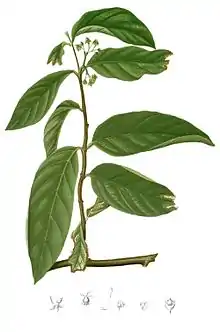| Salacia chinensis | |
|---|---|
 | |
| Scientific classification | |
| Kingdom: | Plantae |
| Clade: | Tracheophytes |
| Clade: | Angiosperms |
| Clade: | Eudicots |
| Clade: | Rosids |
| Order: | Celastrales |
| Family: | Celastraceae |
| Genus: | Salacia |
| Species: | S. chinensis |
| Binomial name | |
| Salacia chinensis | |
| Synonyms | |
|
Click to expand
| |
Salacia chinensis is a species of plant in the family Celastraceae.[1] A climbing shrub, it is also known as Chinese salacia, lolly berry,[2] and saptachakra in Ayurveda.[3] The plant is found widespread in South-East Asia and Australoceania.
Description
Leaves are elliptic, narrowly ovate-round or obovate-elliptic 4.2-10.5 cm long and 2.2-4.0 cm wide, and glabrous; the petioles are 5–8 mm long. The fruit has one seed in it, the seed is only 8 mm long. Flowers have five petals and they are yellow or yellowish-green.
References
Wikimedia Commons has media related to Salacia chinensis.
- ↑ Contributions from the United States National Herbarium. Smithsonian Institution Press. 2003. pp. 192–.
- ↑ Jules Janick; Robert E. Paull (2008). The Encyclopedia of Fruit and Nuts. CABI. pp. 417–. ISBN 978-0-85199-638-7.
- ↑ C.P. Khare (2004). Indian Herbal Remedies: Rational Western Therapy, Ayurvedic, and Other Traditional Usage, Botany. Springer Science & Business Media. pp. 410–. ISBN 978-3-540-01026-5.
This article is issued from Wikipedia. The text is licensed under Creative Commons - Attribution - Sharealike. Additional terms may apply for the media files.